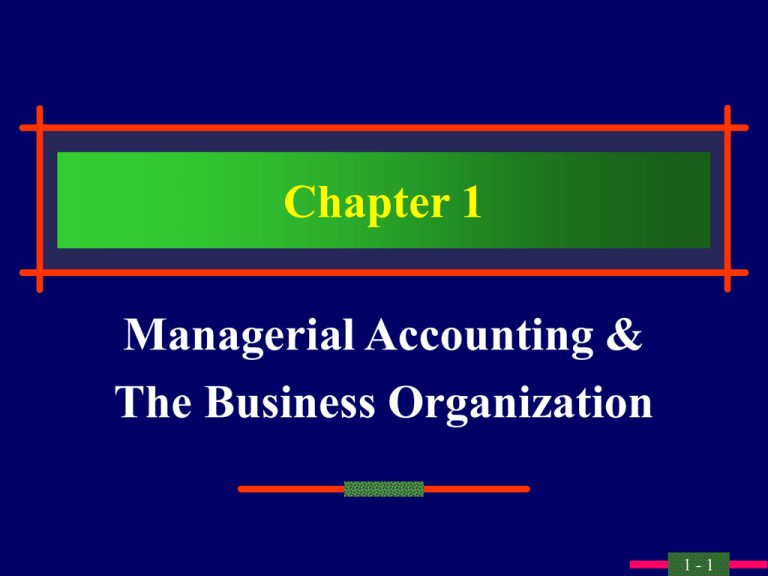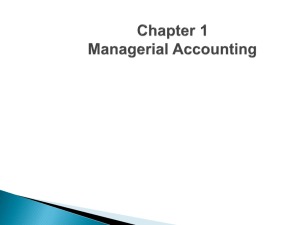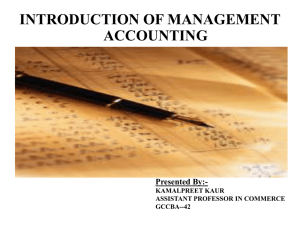Chapter 1 Managerial Accounting & The Business Organization 1 - 1
advertisement

Chapter 1 Managerial Accounting & The Business Organization 1-1 Objective 1 Describe the major users of accounting information. 1-2 Users of Accounting Information Internal managers… use information for short-term planning and controlling routine operations. use information for making nonroutine decisions and formulating overall policies and long-range plans. 1-3 Users of Accounting Information External parties: use information for Investors making decisions Government authorities about the company. 1-4 Management Accounting What is Management Accounting? It is the process of identifying, measuring, accumulating, analyzing, preparing, interpreting, and communicating information that managers use to fulfill organizational objectives. 1-5 Financial Accounting What is Financial Accounting? It refers to accounting information developed for the use of external parties such as stockholders, suppliers, banks, and government regulatory agencies. 1-6 Uses of Accounting Information Scorekeeping is the accumulation and classification of data. Attention directing involves reporting and interpreting information. Problem solving quantifies the likely results of possible courses of action. 1-7 Accounting Systems An accounting system is a formal mechanism for gathering, organizing, and communicating information about an organization’s activities. 1-8 Accounting Systems Generally accepted accounting principles (GAAP) include broad guidelines and detailed rules and procedures that make up accepted accounting practices at a given time. Internal accounting reports need not be restricted by GAAP. 1-9 Service Organizations Labor is intensive. Output is usually difficult to define. Major inputs and outputs cannot be stored. 1 - 10 Objective 2 Explain the cost-benefit and behavioral issues involved in designing an accounting system. 1 - 11 Accounting System Costs and Benefits Benefits Costs Benefits Costs Obtain system Costs Seek alternatives Benefits > < 1 - 12 Accounting System Costs and Benefits The accounting system’s effect on the behavior (decisions) of managers should be considered. If the system fails to provide information that is timely or in a useful format, there will be a lack of acceptance by users. 1 - 13 Objective 3 Explain the role of budgets and performance reports in planning and control. 1 - 14 Planning and Controlling What is decision making? It is the purposeful choice from among a set of alternative courses of action designed to achieve some objective. This is the core of the management process. 1 - 15 Planning and Controlling Corrections and Revisions of Plans and Actions The Management Process Planning •Increase Productivity Controlling •Actions •Evaluations Internal Accounting System Budgets, Special Reports Financial Accounting System Performance Reports Customer surveys Competitor analysis Advertising impact New items report 1 - 16 Role of Budgets A budget is a quantitative expression of a plan of action and is an aid to coordinating and implementing the plan. Budgets are the chief devices for compelling and disciplining management planning. 1 - 17 Role of Performance Reports Performance reports formalize controls and provide feedback by comparing results with plans and by highlighting variances. Variances are deviations from the plan. 1 - 18 Performance Report Budgeted Actual Amount Amount Revenues 25,000 19,000 Expenses 20,000 15,000 Net Income 5,000 4,000 F = Favorable U = Unfavorable Variance Amount 6,000 U 5,000 F 1,000 U 1 - 19 Objective 4 Discuss the role accountants play in the company’s value chain functions. 1 - 20 Product Life Cycle Product Development Introduction to Market Mature Market Product Phase-out 1 - 21 Value Chain Research and Development Marketing Design Production Distribution Customer Service 1 - 22 Value Chain Functions Research and development… is the generation of, and experimentation with, ideas related to new products, services, or processes. 1 - 23 Value Chain Functions Design… is the detail and engineering of products. 1 - 24 Value Chain Functions Production… is the coordination and assembly of resources to produce a product or deliver a service. 1 - 25 Value Chain Functions Marketing… is the manner by which individuals or groups learn about the value and features of products or services. 1 - 26 Value Chain Functions Distribution… is the mechanism by which products or services are delivered to the customer. 1 - 27 Value Chain Functions Customer service… is the support activities provided to the customer. 1 - 28 Objective 5 Contrast the functions of controllers and treasurers. 1 - 29 Authority and Responsibility Line authority is granted to managers who supervise subordinates and are accountable for assets and operations. Staff authority is the authority to advise and support management personnel. 1 - 30 Organization Chart Controller General Accounting Internal Audit Taxes 1 - 31 Functions of the Controller 1 2 3 4 5 6 7 Planning for control Reporting and interpreting Evaluating and consulting Tax administration Government reporting Protection of assets Economic appraisal 1 - 32 Functions of the Treasurer 1 2 3 4 5 6 7 Provision of capital Investor relations Short-term financing Banking and custody Credits and collections Investments Risk management (insurance) 1 - 33 Objective 6 Identify current trends in management accounting. 1 - 34 Current Management Accounting Trends Factors causing changes in management accounting: Shift from a manufacturing-based to a service-based economy Increased global competition Advances in technology Changes in business processes 1 - 35 Advances in Technology E-Commerce: conducting business online. B2C, B2C. Enterprise resource planning (EPR) systems: integrated information systems that support all functional areas of a company. XBRL (eXtensible Business Reporting Language) that helps communicate financial information electronically 1 - 36 Changes in Business Processes Just-in-Time (JIT) What is the just-in-time philosophy? Eliminate waste by reducing the time products spend in the production process. Eliminate the time products spend in activities that do not add value. 1 - 37 Computer-Aided Design (CAD)... allows companies to design products that can be manufactured efficiently. Even small changes in design often lead to large manufacturing cost savings. – 1 - 38 Computer-Aided Manufacturing (CAM)... allows computers to direct and control production equipment. CAM often leads to a smoother, more efficient flow of production with fewer delays. – 1 - 39 Computer-Integrated Manufacturing (CIM)... utilizes both CAD and CAM together with robots and computer-controlled machines. The small amount of labor required in this manufacturing process allows for great flexibility since changes are made to computer programs without retraining an entire workforce. – 1 - 40 Changes in Business Processes TQM: initiates that minimize costs by maximizing quality. Six Sigma: a continuous process improvement effort designed to reduce costs by improving quality. 1 - 41 Objective 7 Explain a management accountant’s ethical responsibilities. 1 - 42 Standards of Ethical Conduct Management accountants have an obligation to the organizations they serve with the following standards: Competence Confidentiality Integrity Objectivity 1 - 43 Objective 8 Understand how managerial accounting is used in companies. 1 - 44 Vital Role of Accounting Information Management accounting plays a vital role in the achievement of company goals and objectives. Management accounting information is used across the entire value chain of activities as well as throughout the life cycle of products and services. 1 - 45




